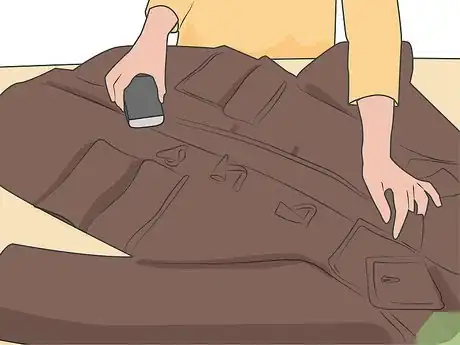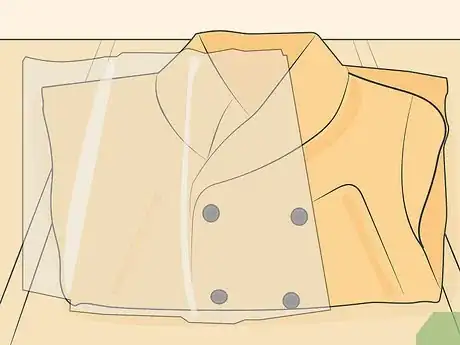This article was co-authored by Robert Rybarski. Robert Rybarski is an Organizational Specialist and Co-Owner of Conquering Clutter, a business that customizes closets, garages, and plantation shutters to ensure organized homes and lifestyles. Robert has over 23 years of consulting and sales experience in the organization industry. His business is based in Southern California.
This article has been viewed 16,307 times.
Wool coats are great for keeping you cozy and warm in the winter, but they take up unnecessary closet space during warmer months when you won’t be using them. When spring and summer roll around, you might want to store your wool coat along with other winter clothes to make room for your summer wardrobe. Storing a wool coat properly will also help it retain its shape and protect it from moths during the summer, so you can be sure it will be in good condition when you need it next winter. Make sure to wash and dry your coat before you store it to protect and preserve it for many winters yet to come!
Steps
Cleaning Wool Coats for Storage
-
1Check the coat’s care tag for any special washing instructions. The care tag will advise you what washing methods are safe for the coat. Take note of information about what wash cycle, water temperature, and detergent to use on a washing machine.[1]
- Don’t skip washing your wool coat before you store it, even if it doesn’t seem dirty. Human odours and oils can attract moths or make your wool coat deteriorate or develop a funky smell in storage.
- Wool is generally safe to wash by hand or using a gentle cycle in a washing machine, but your coat might be lined with non-washable materials. In this case the tag will say it is “dry clean only.”
-
2Pre-treat any stains with stain remover or mild liquid dish detergent. Apply the stain remover or dish detergent to the stain and gently work it in with your fingers. Allow the treatment to sit for 10 minutes before you proceed to wash the coat.[2]
- If you use a stain remover product, check the label first to make sure it is safe for wool.
Advertisement -
3Fasten any buttons and zippers on the coat. Close the front of the coat and zip up or fasten any pockets. This will cut down on the risk of anything snagging or tearing when you wash the coat.[3]
- This will also help your coat keep its form while you wash and dry it.
-
4Wash the coat according to the care label’s instructions. Wash the coat with cold water by hand or on a gentle cycle in the laundry machine using detergent designed for wool products. Get it dry cleaned if the care label says it is dry clean only.[4]
- Some laundry machines even have an extra-gentle “wool” cycle that you can use.
- Wash the coat separately from other items if you wash it in a machine.
Tip: Never use hot water or regular detergents to wash your wool coat. They can break down or shrink the fibers and ruin your coat.
-
5Lay the coat flat to air dry it. Lay the coat out on a drying rack or a flat hard surface, such as a laundry table. Spread the arms out all the way and smooth the coat out with your hands to help it retain its shape.[5]
- If you lay the coat out on a flat surface rather than a drying rack, make sure you turn it over periodically so both sides dry evenly.
- Avoid hanging the coat to dry. The wet wool will be very heavy, so it can lose it’s form quite easily if you hang dry it.
Packing up Wool Coats Safely
-
1Put your coat on a sturdy hanger in a garment bag if you want to hang it. Hang the coat on a chunky wooden hanger to help it keep its shape and avoid wrinkles and creases in the shoulders. Seal your coat up in a fabric garment bag to protect it from dust and mildew.[6]
- You can get a single-coat garment bag or a large boxy garment bag that you can hang multiple items in.
-
2Place the coat in an airtight plastic bin for the most protection. Choose a bin that is at least big enough to fit the coat without cramming it in. Gently pace your folded and wrapped coat into the bin.[7]
- A sealable, airtight container is the best option for storing your wool coat because it will keep out all moisture, humidity, dust, and dirt.
- Use a clear bin if you want to be able to easily see what’s inside when you’re looking for your winter coat later on.
Tip: If you don’t have space for a plastic bin, you could also store your coat in a vacuum-sealed plastic bag. The important thing is that you store it somewhere airtight to keep out moisture and humidity.
-
3Fold the coat up gently in acid-free tissue paper and put it in a bin. Lay the coat out on a flat surface with the arms spread out and smooth out any wrinkles or bumps. Fold it up into a neat square or rectangular shape, then wrap it up loosely with acid-free tissue paper.[8]
- Tissue paper will protect the wool and let it breathe in storage. Make sure you only use acid-free tissue paper because the acids in regular tissue paper can break down the wool fibers over time.
-
4Put 1-2 sprigs of lavender or pieces of cedar with the coat to ward off moths. Both lavender and cedar are natural moth repellents, and they smell much better than moth balls. Place these on top of the coat if you folded it up or stick them in a couple of pockets if you plan to hang it to ensure that moths aren’t attracted to it while it’s in storage.[9]
- Lavender and cedar also act as deodorizers, so your coat will smell nice and fresh when you pull it out of storage next winter.
-
5Pack other wool items loosely with the coat if you have space left. Put other winter items like sweaters, hats, or scarves with your wool coat if you want to utilize extra space in your chosen storage location. Avoid cramming items together so the wool still has room to breath and your coat won’t get wrinkled.[10]
- Make sure that any items you store with the coat are also freshly laundered so they don’t contaminate the coat with odors or dirt.
Choosing a Storage Location
-
1Store the coat in a cool spot where the temperature doesn’t fluctuate. Pick a storage location in your home where the coat will not be exposed to extreme hot or cold temperatures. Very high or low temperatures can damage wool fibers.[11]
- For example, you could put the coat in a bedroom closet or under your bed.
-
2Place the coat in a dark location to avoid damage from light exposure. Select a spot to store the coat where it won’t be exposed to sunlight. Light exposure can fade the color of your wool coat.[12]
- For instance, don’t store the coat by a window. Pick a storage location like a closet with a door you can close to block out light.
-
3Choose a dry storage location to avoid damage from moisture and humidity. Make sure the storage place you pick stays dry and isn’t affected by humidity. Moisture and humidity can damage wool and ruin your coat.[13]
- Don’t store your coat in a garage or attic where moisture and humidity can occur.
-
4Dedicate a space to storing clothing to make seasonal transitions easier. Rotate your winter and summer clothes in and out of storage when the seasons change.[14] This will ensure that the total amount of space your clothes take up remains more or less the same throughout the year.[15]
- For instance, you could dedicate the top shelf of your closet to clothing storage.
Expert Q&A
Did you know you can get expert answers for this article?
Unlock expert answers by supporting wikiHow
-
QuestionWhat can I do with bulky winter coats when I'm not using them so they don't take up space?
 Robert RybarskiRobert Rybarski is an Organizational Specialist and Co-Owner of Conquering Clutter, a business that customizes closets, garages, and plantation shutters to ensure organized homes and lifestyles. Robert has over 23 years of consulting and sales experience in the organization industry. His business is based in Southern California.
Robert RybarskiRobert Rybarski is an Organizational Specialist and Co-Owner of Conquering Clutter, a business that customizes closets, garages, and plantation shutters to ensure organized homes and lifestyles. Robert has over 23 years of consulting and sales experience in the organization industry. His business is based in Southern California.
Organizational Specialist You can put them in a spare closet, or you can put them in the back of your regular closet during the warmer months so they're not in the way. Some people will take them and fold them up and then either box or bag them and put them away in a different room so they don't take up space in their closet.
You can put them in a spare closet, or you can put them in the back of your regular closet during the warmer months so they're not in the way. Some people will take them and fold them up and then either box or bag them and put them away in a different room so they don't take up space in their closet.
Things You’ll Need
- Stain remover or dish detergent
- Wool laundry detergent
- Acid-free tissue paper (optional)
- Airtight plastic bin (optional)
- Wood hanger (optional)
- Fabric garment bag (optional)
- Lavender or cedar
References
- ↑ https://makespace.com/blog/posts/how-to-wash-and-store-winter-coats/
- ↑ https://www.realsimple.com/beauty-fashion/clothing-care/storing-winter-clothes
- ↑ https://makespace.com/blog/posts/how-to-wash-and-store-winter-coats/
- ↑ https://www.bhg.com.au/how-to-store-your-wool-clothing
- ↑ https://makespace.com/blog/posts/how-to-wash-and-store-winter-coats/
- ↑ https://makespace.com/blog/posts/how-to-wash-and-store-winter-coats/
- ↑ https://www.lifestorage.com/blog/storage/storing-winter-clothing-during-the-summer-months/
- ↑ https://www.realsimple.com/beauty-fashion/clothing-care/storing-winter-clothes
- ↑ https://www.realsimple.com/beauty-fashion/clothing-care/storing-winter-clothes
- ↑ https://www.realsimple.com/beauty-fashion/clothing-care/storing-winter-clothes
- ↑ https://www.lifestorage.com/blog/storage/storing-winter-clothing-during-the-summer-months/
- ↑ https://www.lifestorage.com/blog/storage/storing-winter-clothing-during-the-summer-months/
- ↑ https://www.lifestorage.com/blog/storage/storing-winter-clothing-during-the-summer-months/
- ↑ Robert Rybarski. Organizational Specialist. Expert Interview. 31 January 2020.
- ↑ https://www.lifestorage.com/blog/storage/storing-winter-clothing-during-the-summer-months/










































































